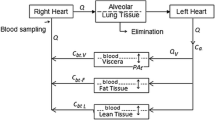Abstract
A physiologically based pharmacokinetic (PB/PK) model has been developed in advanced computer simulation language (ACSL) to describe blood and tissue concentration–time profiles of the C(±)P(−) stereoisomers of soman after inhalation, subcutaneous and intravenous exposures at low (0.8–1.0 × LD50), medium (2–3 × LD50) and high (6 × LD50) levels of soman challenge in three species (rat, guinea pig, marmoset). Allometric formulae were used to compute the compartment volumes, blood flow rates, tidal volume and respiratory rate based upon total animal weight. Blood/tissue partition coefficients for soman, initial carboxylesterase and acetylcholinesterase levels and the rate constants for interactions between soman and these enzymes were species-dependent and were obtained from in vitro measurements reported in the literature. The model incorporated arterial and venous blood, lung, kidney, liver, richly perfused, poorly perfused and fat tissue compartments as well as subcutaneous and nasal exposure site compartments. First-order absorption from linearly filled soman deposits into metabolizing exposure site compartments was employed to model subcutaneous and inhalation exposures. The model was validated by comparing the predicted and observed values for C(±)P(−)-soman in arterial blood at various times following exposure and by regression analysis. Sensitivity analysis was used to determine the effects of perturbations in the model parameters on the time-course of arterial C(−)P(−)-soman concentrations for different exposure routes. In our evaluation of 28 datasets, predicted values were generally within 95% confidence limits of the observed values, and regression coefficients comparing predicted and observed data were greater than 0.85 for 95% of the intravenous and subcutaneous datasets and 25% of the inhalation datasets. We conclude that the model predicts the soman toxicokinetics for doses ≥1 × LD50 for intravenous and subcutaneous exposures and inhalation exposures of 8 min or less sufficiently well to allow its use in the modeling of bioscavenger protection.






Similar content being viewed by others
References
Ainsworth M, Shephard RJ (1961) The intrabronchial distribution of soluble vapours at selected rates of gas flow. In: Davies CN (ed) Inhaled particles and vapours. Pergamon Press, pp 233–247
Benschop HP, De Jong LPA (2001) Toxicokinetics of nerve agents. In: Somani SM, Romano JA (eds) Chemical warfare agents: toxicity at low levels. CRC Press, Boca Raton, pp 25–81
De Jong LPA, Van Dijk C, Berhitoe D, Benschop HP (1993) Hydrolysis and binding of a toxic stereoisomer of soman in plasma and tissue homogenates from rat, guinea pig, and marmoset, and in human plasma. Biochem Pharmacol 46(8):1413–1419
De Jong LPA, Van Dijk C, Benschop HP (1998) Hydrolysis of the four stereoisomers of soman catalyzed by liver homogenate and plasma from rat, guinea pig and marmoset, and by human plasma. Biochem Pharmacol 37(15):2939–2948
Due AH, Trap HC, Langenberg JP, Benschop HP (1994) Toxicokinetics of soman stereoisomers after subcutaneous administration to atropinized guinea pigs. Arch Toxicol 68:60–63
Fiserova-Bergerova V, Hughes HC (1983) Species differences on bioavailability of inhaled vapors and gases. In: Fiserova-Bergerova V (ed) Modeling of inhalation exposure to vapors: uptake, distribution, and elimination. vol 2, CRC Press, Boca Raton, pp 97–106
Gerlowski LE, Jain RK (1983) Physiologically based modeling: principles and applications. J Pharm Sci 72:1103–1127
Gibaldi M, Perrier D (1982) Pharmacokinetics. 2nd edn. Marcel Dekker, New York, pp 364–369
Langenberg JP, Van Dijk C, Sweeney RE, Maxwell DM, De Jong LPA, Benschop HP (1997) Development of a physiologically based model for the toxicokinetics of C(±)P(±)-soman in the atropinized guinea pig. Arch Toxicol 71:320–331
Lenz DE, Broomfield CA, Maxwell DM, Cerasoli DM, (2001) Nerve agent bioscavengers: protection against high- and low- dose organophosphorus exposure. In: Somani SM, Romano JA (eds) Chemical warfare agents: toxicity at low levels. CRC Press, Boca Raton, pp 25–81
Maxwell DM, Wolfe AD, Ashani Y, Doctor BP (1991) Cholinesterase and carboxylesterase as scavengers of organophosphorus agents. In: Massoulie J, Bacou F, Barnard E, Chatonnet A, Doctor BP, Quinn D (eds) Cholinesterase: structure, function, mechanism, genetics, and cell biology. American Chemical Society, Washington, pp 206–209
Maxwell DM, Vlahacos CP, Lenz DE (1988) A pharmacodynamic model for soman in the rat. Toxicol Lett 43:175–188
Newton PE (2002) Fundamental inhalation toxicology. In: Derelanko MJ, Hollinger MA (eds) Handbook of toxicology. CRC Press, Boca Raton, pp 267–334
Ordentlich A, Barak D, Kronman C, Benschop HP, De Jong LPA, Ariel N, Barak R, Segall Y, Velan B, Schafferman A (1999) Exploring the active center of human acetylcholinesterase with stereoisomers of an organophosphorus inhibitor with two chiral centers. Biochemistry 38:3355–3366
Silver A (1974) The biology of cholinesterases, Frontiers of biology. vol. 36, Elsevier, New York, pp 177–302
Acknowledgments
This work was supported by the US Army Medical Research Institute of Chemical Defense and partly through the Army Research Office contract DAA019-02-0-0001 (DO 0573), administered by Battelle. No animals were used in this modeling effort. All animal observations were obtained from previously published sources.
Author information
Authors and Affiliations
Corresponding author
Rights and permissions
About this article
Cite this article
Sweeney, R.E., Langenberg, J.P. & Maxwell, D.M. A physiologically based pharmacokinetic (PB/PK) model for multiple exposure routes of soman in multiple species. Arch Toxicol 80, 719–731 (2006). https://doi.org/10.1007/s00204-006-0114-0
Received:
Accepted:
Published:
Issue Date:
DOI: https://doi.org/10.1007/s00204-006-0114-0




